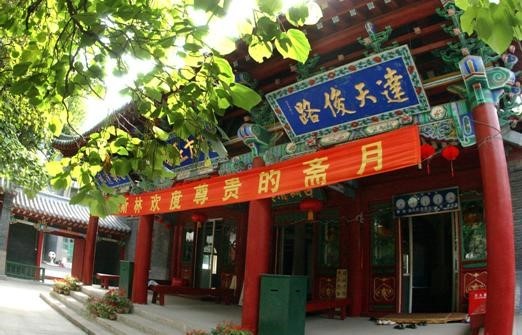ENG
Mosques In China
Shenyang
Qiyimen Mosque
Address: No. 67, Qiyi Street, Wuhan
Qiyimen mosque complex covers an area of 2,300 square meter with a capacity of 500 people.
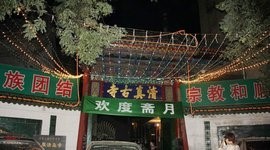
Jiang'an Mosque
Address: No. 83, Yongheli, Erqi Street, Jiang'an District, Wuhan
Jiang’an Mosque was called Liujiamiao Mosque, also called Erqijie Mosque, it was started from a simple mosque built on 1918. In 1920, local Muslims raised fund and bought a small building next to it and used as a new mosque, however it was destroyed in 1937 by war. Then local Muslims raised fund again and purchased the building at current location and restore the mosque. In 2002, municipal government decided to renovate it as it too old to use, and the renovation was completed in 2006.

Minquan Road Mosque
Address: No. 146, Minquan Road, Hankou, Wuhan
Minquan Road Mosque situated at 146 Minquan road, original name Guangyi bridge mosque, folk name Hubei temple or Qingzhen later temple. First built in the first year of Yongzheng, Qing dynasty (1623). Burnt several times in Guangxu and Xuantong years of Qing dynasty, restored in 1916.In 1930, the mosque was moved to the current place due to road expansion.
Now the mosque is facing south, with an area of 530 square metre. It was three floor brick building, with Arabian dome style, the construction area is 750 square meter. The base floor is parlour, water room, sacred relic room; second floor is scripture study room and preaching room; third floor is the bethel hall, can accommodate more than 300 people. In 1986, the government expand the building to 5 storey, increase in room furniture, and newly renovated. Now the mosque has become the activity center of the Muslims in the city, also the bethel for foreign Muslim friends.
Now the mosque is facing south, with an area of 530 square metre. It was three floor brick building, with Arabian dome style, the construction area is 750 square meter. The base floor is parlour, water room, sacred relic room; second floor is scripture study room and preaching room; third floor is the bethel hall, can accommodate more than 300 people. In 1986, the government expand the building to 5 storey, increase in room furniture, and newly renovated. Now the mosque has become the activity center of the Muslims in the city, also the bethel for foreign Muslim friends.
Lhasa Great Mosque
Address: Hebalin, Lhasa, Tibet
Lhasa Great Mosque was originally built in 1716. It underwent renovation in 1959 to what the building looks today. The mosque has a three-entrance courtyard which covers a total area of 2,600 m2.
The buildup area covers an area of 1,300 m2 which consists of the prayer hall, Pai building, bunker building, ablution hall, bathroom and other facilities. The prayer hall is located in the west which covers an area of 285 m2 which consists of inner hall, open hall and main platform. The building architecture is the traditional Zang architecture style and also combines religious and local features.
The buildup area covers an area of 1,300 m2 which consists of the prayer hall, Pai building, bunker building, ablution hall, bathroom and other facilities. The prayer hall is located in the west which covers an area of 285 m2 which consists of inner hall, open hall and main platform. The building architecture is the traditional Zang architecture style and also combines religious and local features.
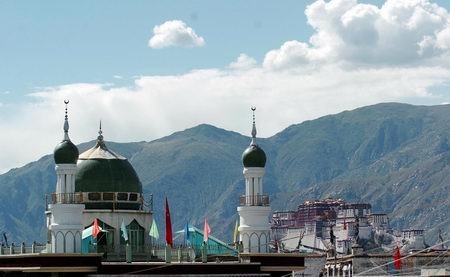
Id Kah Mosque
Id Kah is the largest mosque in China. Every Friday, it houses nearly 10,000 worshippers and may accommodate up to 20,000.
The mosque was built by Saqsiz Mirza in ca. 1442 (although it incorporated older structures dating back to 996) and covers 16,800 square meters.
On 9 August 1933, Chinese Muslim General Ma Zhancang killed and beheaded the Uyghur leader Timur Beg, displaying his head on a spike at Id Kah mosque.
In March 1934, it was reported that the Uyghur emir Abdullah Bughra was also beheaded, the head being displayed at Id Kah mosque.[6][7]
In April 1934, the Chinese Muslim general Ma Zhongying gave a speech at Id Kah Mosque in Kashgar, telling the Uyghurs to be loyal to the Republic of China Kuomintang government of Nanjing.
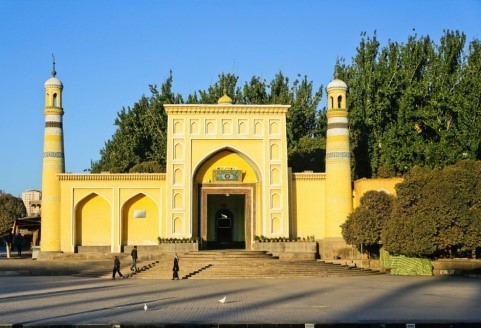
Turpan Emin Minaret Mosque
Address: Munaer Village, East Surburb of Turpan
The Emin Minaret or Emin Tower stands by the Uyghur mosque located in Turfan, Xinjiang, China. At 44 meters (144 ft) it is the tallest minaret in China. The Qing Empire conquered this largely Muslim region in the 1750s by defeating the Dzungar Mongols with their superior weaponry in a series of battles. The Uyghurs under Emin Khoja joined the Qing Empire for protection against the Dzungars and the Emin minaret was named after Emin Khoja.
The minaret was started in 1777 during the reign of the Qianlong Emperor (r. 1735–1796) and was completed only one year later. It was financed by local leaders and built to honor the exploits of a local Turpan general, Emin Khoja, hence the name "Emin". The Emin Minaret is located along the ancient Silk Route (near the ancient Uyghur capital of Gaochang). Nearby is the site of the Bezeklik Thousand Buddha Caves.
The arid landscape of southern Xinjiang has long been connected to both East Asia and West Asia by historical trade routes such as the Silk Road and the land around these crossroads became the location for most of the Uyghur Islamic structures in Xinjiang. The area has long served as a conduit for cultural exchange between different ethnic and religious groups. The Emin Minaret, like other Uyghur mosques and minarets, reflects this in its combination of traditional Islamic features and local Uyghur building traditions.
The Emin Minaret was constructed by local craftsmen using local materials. The structure itself is made of wood and brick. It is an elegant, circular, tapered Islamic dome, with a diameter over 14 meters (46 feet) at its base and tapering to 2.8 meters at the top. The exterior is of sun-dried yellow bricks that narrow in shape as the tower rises. The richly textured bricks are carved into intricate, repetitive, geometric and floral mosaic patterns, such as stylized flowers and rhombuses. This mixture of Chinese and Islamic features is seen only in minarets in China. The unique geometric patterns are characteristic of Islamic architecture and have no counterparts in the architecture of China other than in Muslim structures. Positioned in the tower are several long, narrow windows at different heights and facing different directions that provide light and ventilation.The minaret has no stories. Inside, the spiraling internal support serves as a winding 72-step staircase to the top.
The Emin Minaret is on the northeast corner of the Uyghur Mosque, a rectangular structure with an iwan or mihrab, a pointed-arch niche enclosed on three sides but open to a large covered courtyard on the fourth. The mosque is divided into an inner hall for use in colder months and larger outer halls for warmer months. The outer halls are built with elegant, tall, thin, wooden pillars and beams supporting its exposed timber frame, and are open and spacious, while the inner hall is small and enclosed.
The towering architectural shape of a minaret, always taller than it is wide, is a clear sign of the presence of Islam as are the abstract, geometric decorative elements. Although the minaret has served many functions over time, in Islam its primary function has always been as the main lookout around which to draw members of the community. The ground floor of a minaret is always square while the higher parts may be of varying shapes, including round, square, or octagonal. The minaret is the most distinctive feature of any mosque and this is no different in the case of the Emin Minaret.
The minaret was started in 1777 during the reign of the Qianlong Emperor (r. 1735–1796) and was completed only one year later. It was financed by local leaders and built to honor the exploits of a local Turpan general, Emin Khoja, hence the name "Emin". The Emin Minaret is located along the ancient Silk Route (near the ancient Uyghur capital of Gaochang). Nearby is the site of the Bezeklik Thousand Buddha Caves.
The arid landscape of southern Xinjiang has long been connected to both East Asia and West Asia by historical trade routes such as the Silk Road and the land around these crossroads became the location for most of the Uyghur Islamic structures in Xinjiang. The area has long served as a conduit for cultural exchange between different ethnic and religious groups. The Emin Minaret, like other Uyghur mosques and minarets, reflects this in its combination of traditional Islamic features and local Uyghur building traditions.
The Emin Minaret was constructed by local craftsmen using local materials. The structure itself is made of wood and brick. It is an elegant, circular, tapered Islamic dome, with a diameter over 14 meters (46 feet) at its base and tapering to 2.8 meters at the top. The exterior is of sun-dried yellow bricks that narrow in shape as the tower rises. The richly textured bricks are carved into intricate, repetitive, geometric and floral mosaic patterns, such as stylized flowers and rhombuses. This mixture of Chinese and Islamic features is seen only in minarets in China. The unique geometric patterns are characteristic of Islamic architecture and have no counterparts in the architecture of China other than in Muslim structures. Positioned in the tower are several long, narrow windows at different heights and facing different directions that provide light and ventilation.The minaret has no stories. Inside, the spiraling internal support serves as a winding 72-step staircase to the top.
The Emin Minaret is on the northeast corner of the Uyghur Mosque, a rectangular structure with an iwan or mihrab, a pointed-arch niche enclosed on three sides but open to a large covered courtyard on the fourth. The mosque is divided into an inner hall for use in colder months and larger outer halls for warmer months. The outer halls are built with elegant, tall, thin, wooden pillars and beams supporting its exposed timber frame, and are open and spacious, while the inner hall is small and enclosed.
The towering architectural shape of a minaret, always taller than it is wide, is a clear sign of the presence of Islam as are the abstract, geometric decorative elements. Although the minaret has served many functions over time, in Islam its primary function has always been as the main lookout around which to draw members of the community. The ground floor of a minaret is always square while the higher parts may be of varying shapes, including round, square, or octagonal. The minaret is the most distinctive feature of any mosque and this is no different in the case of the Emin Minaret.
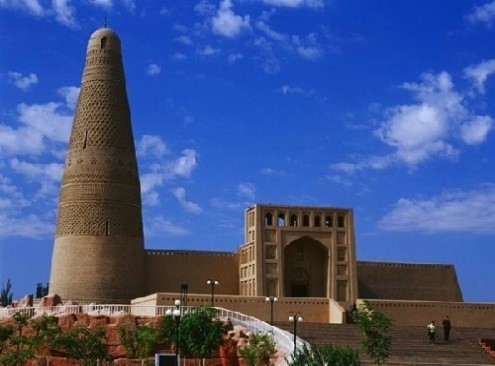
Urumqi Tartar Mosque
Address: South Jiefang Road, Urumqi
The Tatar Mosque is considered one of the oldest mosques in Urumqi. It was built in 1897 on funds raised by the local Tatar diaspora. Then it became a religious complex with a total area of 3,000 square meters. This is one of the largest mosques in the city, which can accommodate over a thousand people.
The Tatar Mosque was built in traditional style. All the walls, doors and windows of the mosque are decorated with various carvings and traditional ornaments in the form of plants and geometric shapes. The central tower of the mosque is covered with gold, which is typical for Tatar religious monuments. In addition to the mosque the complex territory includes rooms for Quran study, the private rooms of the Imam, as well as the reception hall and utility rooms.
Today, the major part of the Urumqi population goes to the Tatar Mosque, they are not only the Uyghurs, but also other representatives of the national minorities who live in the city: the Kazakhs, Uzbeks, Tatars, Dungans. The Tatar Mosque is an important Islamic center, playing a significant role in the lives of local people.
The Tatar Mosque was built in traditional style. All the walls, doors and windows of the mosque are decorated with various carvings and traditional ornaments in the form of plants and geometric shapes. The central tower of the mosque is covered with gold, which is typical for Tatar religious monuments. In addition to the mosque the complex territory includes rooms for Quran study, the private rooms of the Imam, as well as the reception hall and utility rooms.
Today, the major part of the Urumqi population goes to the Tatar Mosque, they are not only the Uyghurs, but also other representatives of the national minorities who live in the city: the Kazakhs, Uzbeks, Tatars, Dungans. The Tatar Mosque is an important Islamic center, playing a significant role in the lives of local people.
Urumqi Shaanxi Mosque
Address: Jianzhong Road, North, Urumqi
Shaanxi Mosque is the largest mosque in Urumqi and also the location of Islamic Association of Urumqi. The mosque was built in Qing Dynasty(1644-1911). The mosque is a traditional Chinese style building and the prayer hall is 10 meters high. In front of the hall is a spacious courtyard. There are rooms around the yard except the west side. The north hall is the classroom. The south hall is the wudu area. The east hall is the Imam’s office.
Urumqi South Mosque
Address: Erdaoqiao, South Jifang Road, Urumqi , Xinjiang
The Urumqi South Mosque was built in 1919 and rebuilt for three times, it is in downtown Urumqi, and was listed as a historic cultural building in 1985 by Urumqi municipal government. The current mosque covers an area of 464 square meters. The prayer hall combined by outer and inner parts. The inner hall can hold 300 people to do prayer and the outer hall can hold 500 people.
Urumqi Salar Mosque
Address: South Heping Road, Urumqi , Xinjiang
The Salar Mosque is one of the oldest mosques in Urumqi. This two story structure is located on Salasi Alley, and is in an area where many of the well known mosques are located. It was constructed in 1865, and has a rounded shape which faces the road. The green dome and single minaret are the other prominent features. The windows of the mosque are in the shape of a house with a triangular roof. In between each of the large windows is a small circular window.
The minaret is in four sections, with the bottom in similar design to the mosque windows, with circular openings above. The second section is the most attractive, as there is a "wavy" design made of blue and white tiles. The upper section has white tiles and is topped by a gold crescent shape, which is expected to be seen on most mosques. The Salar community is one of the many diverse ethnic groups which make up the Urumqi region. They are of Turkic origin, and have a history in China which can be traced back to the Tang Dynasty. They are mainly found in the Xunhua Salar Autonomous County and Salar Autonomous County of Gansu. Another ethnic minority are the Tartars who have a mosque on nearby Jeifang South Road.
The minaret is in four sections, with the bottom in similar design to the mosque windows, with circular openings above. The second section is the most attractive, as there is a "wavy" design made of blue and white tiles. The upper section has white tiles and is topped by a gold crescent shape, which is expected to be seen on most mosques. The Salar community is one of the many diverse ethnic groups which make up the Urumqi region. They are of Turkic origin, and have a history in China which can be traced back to the Tang Dynasty. They are mainly found in the Xunhua Salar Autonomous County and Salar Autonomous County of Gansu. Another ethnic minority are the Tartars who have a mosque on nearby Jeifang South Road.

Guyuan Great Mosque
Address: 60 Guyuan 1 Alley, Heping Road South, Tianshan District, Urumqi, Xinjiang
This mosque is located near the south gate of Urumqi. Originally the old Beiliang Mosque, which was built in 1865, the mosque became a center of worship for many immigrants from Guyuan, Ningxia Hui Autonomous Region, from whence it took its current name. The building was relocated in 1952 and renovated in 1998.
The four angular minarets are a mixture of Islamic design and the hexagonal pavilions of the central Chinese plains in ancient times. The building as a whole has a distinctively Islamic look, but the ablution and office sections have green-tiled, upturned eaves adorned with mythical animal figures in the traditional Han ethnic style.
The four angular minarets are a mixture of Islamic design and the hexagonal pavilions of the central Chinese plains in ancient times. The building as a whole has a distinctively Islamic look, but the ablution and office sections have green-tiled, upturned eaves adorned with mythical animal figures in the traditional Han ethnic style.
Jinjiayao Mosque
Address: Jinzhong Estate, Jinhai Road, Tianjin
Built in 1574, Jinjiayao is the oldest mosque in Tianjin. Established by a roaming Muslim from Anhui Province, this mosque has been repaired and enlarged on five separate occasions to accommodate the area's steadily increasing Muslim population. The most recent renovation was completed in 2002, the new floor plan spanning a total of 2023 square meters.
Liulin Mosque
Address: Liulin Road, Tianjin
Liulin Mosque is a new mosque which was built in 2005 in order to serve the local Muslim community. The mosque received its name because it is in Liulin Road. The mosque is in Arabic style, outside wall is decorated by mosaic. It covers an area of 2730.94 square meter, and the building covers 975 square meters. It have three halls, the one in the middle is the male prayer hall which could hold more than 200 people pray at the same time. The other two halls covers 75 square meters, one is meeting room and the other one is female prayer hall. The whole mosque also includes other meeting rooms, offices and Imam’s office, Wudu area, etc.
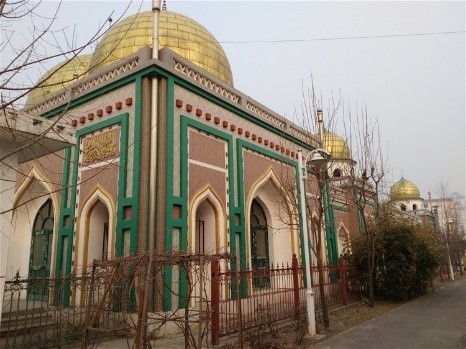
Xiningdao Mosque
Address: No.43 Xiningdao, Tianjin
Xiningdao Mosque is located at 55 Xiningdao Street, Heping district, Tianjin city, China. The mosque was built on May 1, 1991 and operates on March 2, the first day of Ramadan next year. This mosque area has an area of one thousand square meters. The mosque incorporates traditional Chinese and Arab architecture. The prayer hall, located on the second floor of 185 square meters, can accommodate 200 people in prayer.
Meanwhile, the daily prayer room is located on the first floor of 21 square meters and accommodates 20 worshipers together at one time. In 1998 and 1999, the local government allocated RMB 70,000 and 200,000 for repairs to the roof of the prayer room and the azan tower. Subsequently, the local government has provided funds several times to renovate the mosque.
Meanwhile, the daily prayer room is located on the first floor of 21 square meters and accommodates 20 worshipers together at one time. In 1998 and 1999, the local government allocated RMB 70,000 and 200,000 for repairs to the roof of the prayer room and the azan tower. Subsequently, the local government has provided funds several times to renovate the mosque.
Liangjiazui Mosque
Address: Dafeng Road, Tianjin
Liangjiazui Mosque is situated in Tianjin’s Hongqiao District which is also known as where the local Muslim community is located. Liangjiazui Mosque it next to the famous Hongqiao Mosque.
Sidaogou Mosque
Address: Sidaogou Village Road, Tianjin
Sidaogou Mosque is located further out than downtown Tianjin. This is a simple community mosque, surrounded by white wall. However, still attract many people come to look for inner peace.
Tianjin Great Mosque
Address: Qingzhen Lane, Zhenbu Street, Hongqiao District, Tianjin
As one of the most famous mosques in China, Tianjin Great Mosque has been an important Islamic shrine since the beginning of the Qing Dynasty (1644-1911).
Extending over an area of 5000 square meters, the mosque consists of four main structures, the Screen Wall, the Archway, the Prayer Hall and the Preaching Hall. Of these the Prayer Hall is the most active and respected spot in the complex. Even today, over one thousand Muslims from in and around Tianjin come here to worship each week.
While tourists may not enter the building it is possible for them to walk round the courtyard so as to have a close view of the mosque. The Great Mosque lies in the northwest part of the city, Hongqiao District. A visit of half an hour is recommended.

Shijiazhuang Mosque
Address: No. 17, Qingzhensi Street, Xinhua District, Shijiazhuang
Shijiazhuang Mosque was built in 1907 and the current mosque was rebuilt in 1995. The Islamic Association of Shijiazhuang is also located here on the second floor in the general building. The mosque is combined by two buildings: Prayer hall and general hall. The prayer hall building is a two-floor building. The first floor of the prayer hall building is for the regular daily prayer. And the bigger hall on the second floor is for Jumah prayer, and It can hold almost 1,000 people. The general building has three floors. The first floor is wudu area, and the third floor is dormitory.
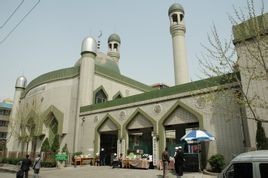
Shenzhen Mosques
Address: No. 7, Meilin East Road, Shenzhen
The Shenzhen Mosque is in Futian District, Shenzhen City, Guangdong Province, China. It is the largest mosque in Shenzhen and is home to Muslim Association of Shenzhen. The mosque is located at an area of 3,000 m2. It consists of the main prayer hall, bunker building, ablution room, garden etc. It was constructed with Arabic architecture style.

Shenyang South Mosque
Address: No. 23, Qingzhen South Road, Shenhe District, Shenyang
The Shenyang South Mosque was built during 1627-1636. The overall design of the Mosque is in traditional Chinese style. The mosque covers an area of 6,117 square meters with a constructed area of 1,706 square meters. It is a three-entrance quadrangle courtyard. The prayer hall is at the center of the mosque. The other major constructions are moon building, kiln hall, classroom. The prayer hall covers an area of 415 square meters. The moon building, occupies an area of 22.5 square meters, is closed to the hall.
